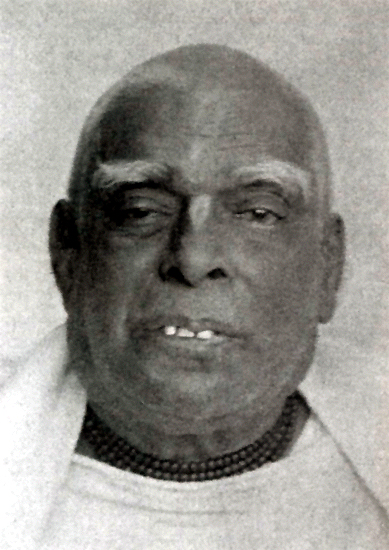
Srila Bhaktivinoda Thakur appeared in 1838 in an aristocratic family of Calcutta. Named Kedarnath, his youth was spent absorbed in studies. A prolific reader and writer, he authored many articles and poems in English. He entered the Hindu School as a student in the class in 1856 at the University of Calcutta, where he studied the philosophical works of Kant, Goethe, Hizel, Swedenburg, Schopenhuer, Hume, Voltaire and others. He later began to study the works of the Brahma movement, along with the Bible and other Christian books, debates between eastern and western thinkers, and the Koran. In his biography, he states that he preferred Christianity to Brahmoism because of Christianity’s clarity as to the transcendence of the one Godhead.
Srila Bhaktivinoda Thakur appeared in 1838 in an aristocratic family of Calcutta. Named Kedarnath, his youth was spent absorbed in studies. A prolific reader and writer, he authored many articles and poems in English. He entered the Hindu School as a student in the class in 1856 at the University of Calcutta, where he studied the philosophical works of Kant, Goethe, Hizel, Swedenburg, Schopenhuer, Hume, Voltaire and others. He later began to study the works of the Brahma movement, along with the Bible and other Christian books, debates between eastern and western thinkers, and the Koran. In his biography, he states that he preferred Christianity to Brahmoism because of Christianity’s clarity as to the transcendence of the one Godhead.
Srila Bhaktivinoda Thakur appeared in 1838 in an aristocratic family of Calcutta. Named Kedarnath, his youth was spent absorbed in studies. A prolific reader and writer, he authored many articles and poems in English. He entered the Hindu School as a student in the class in 1856 at the University of Calcutta, where he studied the philosophical works of Kant, Goethe, Hizel, Swedenburg, Schopenhuer, Hume, Voltaire and others. He later began to study the works of the Brahma movement, along with the Bible and other Christian books, debates between eastern and western thinkers, and the Koran. In his biography, he states that he preferred Christianity to Brahmoism because of Christianity’s clarity as to the transcendence of the one Godhead.
He then moved to Orissa, and continued to write and publish various works. Becoming first a school teacher, and then a Deputy Magistrate at the age of 28. He later moved to Dinajpur where he was appointed Deputy Magistrate. There, he became familiar with Vaisnavism, which was supported under the patronage a great Zamindar of Dinajpur, who was the descendant of Ramananda Vasu, an ardent follower of Sri Caitanya Mahaprabhu. Absorbed in the Caitanya-caritamrita and the Bengali translation of the Bhagavata, he became seriously engaged in the study of Lord Caitanya’s religion in the company of the Vaishnavas at Dinajpur. Continuing his study of comparative religions, he found Vaisnavism to be the perfect consummation of his own realizations.
He was next transferred to Champran, then moved his family to Puri, where his intense devotion to Sri Caitanya grew ever stronger. Along with Gopinatha Pandita, he studied the whole of the Bhagavata with commentary by Sridhara Swami. Two other pandits, who had studied the Nyaya and Vedanta in Navadvipa and Benares, joined him in studying Bhagavata. Kedarnath to learn Sanskrit grammar and literature, having begun these studies in Calcutta. He went on to study Jiva Goswami’s Sadsandarbha, Baladeva Vidyabhusana’s Govinda Bhasya, Prameyaratnavali, Rupa Goswami’s Bhaktirasamrita Sindhu and Hari Bhaktikalpalatika, and other important Vaisnava literatures.
Having mastered the philosophy of Gaudiya Vaishnavism, he wrote additional books in Sanskrit on Gaudiya Vaishnava philosophy. While taking charge of the Jagannath temple and teaching the philosophy, he began the Vidvat Sabha society for promotion of Bhakti literature. Kedarnath stayed in Puri for five years.
Thereafter he was posted to Bengal, and became known as a great Vaisnava Magistrate. Taking initiation, and strictly following the Vaisnava practices, he began the first Vaisnava newspaper. After three years, he began to travel to holy places, and met Jagannath dasa Babaji at Vrindavan. He continued to write, authored many important Vaisnava books over the years.
While staying at Krishnager, he had a vision of a luminous building that filled him with wonder. With old maps and records in hand, he explored it the next day, and discovered there the birthplace of Lord Caitanya Mahaprabhu, which was marked by a large mound covered in Tulasi plants. Shortly afterwards, he authored one of his most famous manuscripts, “Navadvipa Dhama Mahatmya”, which glories all the holy sites within the circle of Navadvipa.
Thakur Bhaktivinoda’s contribution to Vaisnavism is unparalleled. His writings educated many in Bengal and elsewhere in the Vaisnava philosophy, and he established worship of Caitanya Mahaprabhu in Mayapur, which continues as one of the most important sites for Vaisnavas today. Bhaktivinoda Thakur re-established the pure Vaisnava doctrine by expounding the teachings of Lord Caitanya, which had been lost or forgotten over time. Those purporting to be follows of Mahaprabhu had come to think that Smrta ritualistic practices aimed at sense enjoyment were actually devotional service. Srila Bhaktivinoda overturned these practices, along with voidism grown from Buddhism and Shankar’s teachings.
Before disappearing from this world in 1914, His Divine Grace Srila Bhaktivinoda Thakur had firmly re-established the mission of Lord Krsna Caitanya through the ongoing efforts of his son, Srila Bhaktisiddhanta Sarasvati, who was the second in this succession of three nitya-siddha, maha-bhagavata shaktaveysa avataras in the Gaudiya Sampradaya.
The Appearance of HDG Srila Bhaktivinoda Thakur
BY: SUN STAFF
Sep 14, 2016 — CANADA (SUN) — The Appearance of Srila Bhaktivinoda Thakur is observed on this day.
Leave a Reply